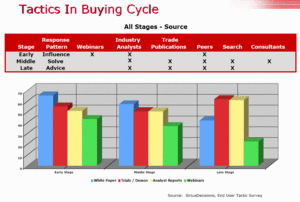Lead Generation Survey
![]() Twice this week I received simply awful telesales calls. The two were remarkably similar, but seemed to come from different companies. Both callers were calling from an overseas (Indian) call centre. Both were pitching professional services (one for development of web 2.0 solutions, the other for outsourced QA) and the purpose of the call was to get me to commit to a subsequent call with a sales rep. In both cases, the telesales rep threw a bunch of buzzwords at me, without being able to explain what they were trying to sell. In neither case did they last beyond 30 seconds (and, no, I did not agree to the subsequent call).
Twice this week I received simply awful telesales calls. The two were remarkably similar, but seemed to come from different companies. Both callers were calling from an overseas (Indian) call centre. Both were pitching professional services (one for development of web 2.0 solutions, the other for outsourced QA) and the purpose of the call was to get me to commit to a subsequent call with a sales rep. In both cases, the telesales rep threw a bunch of buzzwords at me, without being able to explain what they were trying to sell. In neither case did they last beyond 30 seconds (and, no, I did not agree to the subsequent call).
Unfortunately, most of us get calls like that all the time. Despite the many lessons learned about selling and lead generation, it seems that most companies still think it's simply dialing for dollars and a numbers game.
This week, KnowledgeStorm, in conjunction with SiriusDecisions, distributed the results of a market survey of buyers of IT products and services. The paper, entitled Demand Creation: the Prospect's View, was a summary version of a recent webcast they had done, and compiled results from surveying about 1,000 respondents.
Considering the state of telesales, it was not surprising that when asked which delivery mechanism they most often responded to, cold-calling got the lowest score, behind email and direct mail. In fact, when asked which delivery mechanism vendors most get wrong, a whopping 61% of the respondents said cold-calling, with email and direct mail each getting about 10%.
When asked for their most trusted sources, 29% indicated industry analysts, followed by peers and internal groups at 22% and 16%, respectively. Search followed at 14%, seemingly low for the IT community. The bottom of the list was comprised of vendors, VARs and Partners. Well, those three are hardly independent voices, though many would argue that the IT analysts are not as independent as some might perceive.
 Perhaps the most interesting results in the survey, as shown in this table, are how they map the sources used at different stages of the buying cycle. Early in the cycle, webinars, white papers and industry analysts are the leading source, as users are seeking to learn more about a general solution. During the middle stage, as prospects are doing further analysis, demos and trials join white papers as key sources, while webinars begin to decline. At the later stages, when users are making final vendor decisions, trials, along with analyst reports are the key elements. That combination at the end makes me think that people, while legitimately testing out the software, also feel like they want to have a "magic quadrant" to hide behind if the implementation blows up on them.
Perhaps the most interesting results in the survey, as shown in this table, are how they map the sources used at different stages of the buying cycle. Early in the cycle, webinars, white papers and industry analysts are the leading source, as users are seeking to learn more about a general solution. During the middle stage, as prospects are doing further analysis, demos and trials join white papers as key sources, while webinars begin to decline. At the later stages, when users are making final vendor decisions, trials, along with analyst reports are the key elements. That combination at the end makes me think that people, while legitimately testing out the software, also feel like they want to have a "magic quadrant" to hide behind if the implementation blows up on them.
In developing marketing materials for your website and to support direct sales efforts, it's critical to provide different content to support prospects' needs as they move through the buying cycle. This study reinforces that idea that white papers and webinars are among the most effective part of the marking mix early in the sales stage.







Comments